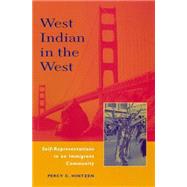West Indian in the West : Self Representations in an Immigrant Community
, by Hintzen, Percy C.- ISBN: 9780814735992 | 0814735991
- Cover: Hardcover
- Copyright: 1/1/2002
As new immigrant communities continue to flourish in U.S. cities, their members continually face challenges of assimilation in the organization of their ethnic identities. West Indians provide a vibrant example.In West Indian in the West , Percy Hintzen draws on extensive ethnographic work with the West Indian community in the San Francisco Bay area to illuminate the ways in which social context affects ethnic identity formation. The memories, symbols, and images with which West Indians identify in order to differentiate themselves from the culture which surrounds them are distinct depending on what part of the U.S. they live in. West Indian identity comes to take on different meanings within different locations in the United States.In the San Francisco Bay area, West Indians negotiate their identity within a system of race relations that is shaped by the social and political power of African Americans. By asserting their racial identity as black, West Indians make legal and official claims to resources reserved exclusively for African Americans. At the same time, the West Indian community insulates itself from the problems of the black/white dichotomy in the U.S. by setting itself apart.Hintzen examines how West Indians publicly assert their identity by making use of the stereotypic understandings of West Indians which exist in the larger culture. He shows how ethnic communities negotiate spaces for themselves within the broader contexts in which they live.







